A New Rotary Global Grant
Scaling up to end malaria in West Timor in Indonesia with Rotary Club of West Perth, Rotary Club of Kupang Central, and the Rotaract Club of Kupang Fortuna. Find out more here.
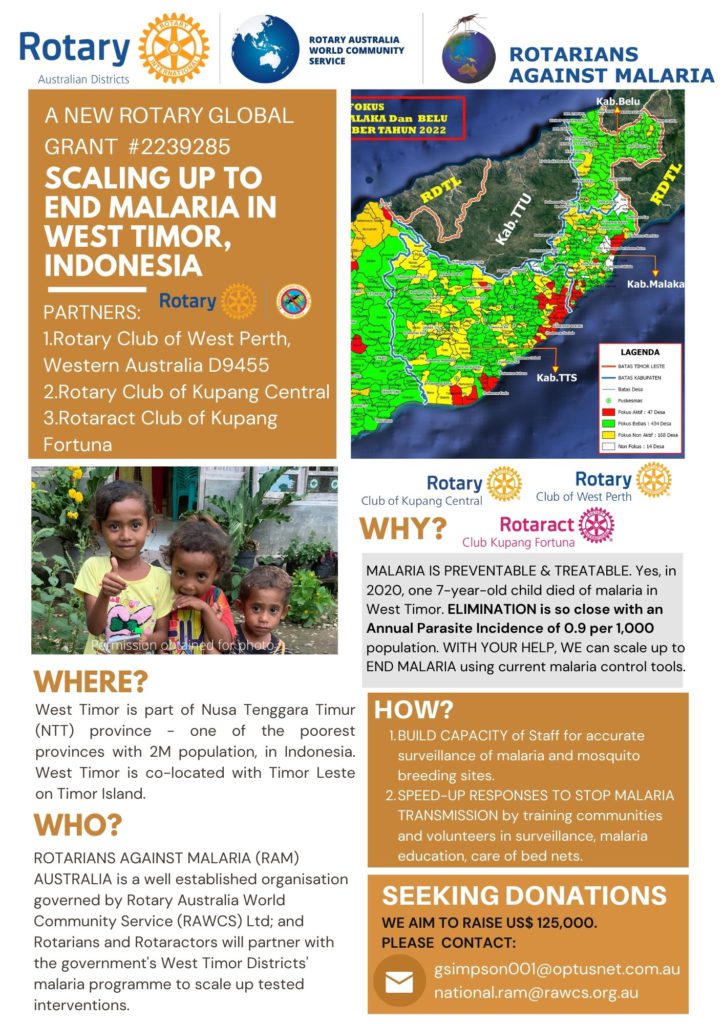
First Rotary Global Grant #2015867 from December 2021 to December 2022
In February 2020, RAM Australia conducted a Community Assessment in West Timor. Learn more in our blog post and in the below video:
WEST TIMOR, NUSA TENGGARA TIMUR PROVINCE, INDONESIA
Abridged version by Jenny Kerrison, PhD, D.Ed., RN, RM
Introduction
The information contained in this section was obtained from Kerrison & Yapabandara (2022), XSPI-RAM Taskforce Report, Scoping Study and Gap Analysis for Acceleration of Malaria Elimination in West Timor (p.18 – 26).
West Timor, NTT province, Indonesia
West Timor is part of the Nusa Tenggara Timur (NTT) Province, Indonesia (see map below). It is located on the western half of the Timor Island and consists of one City and five districts with a population of approximately 2 million in 2019.
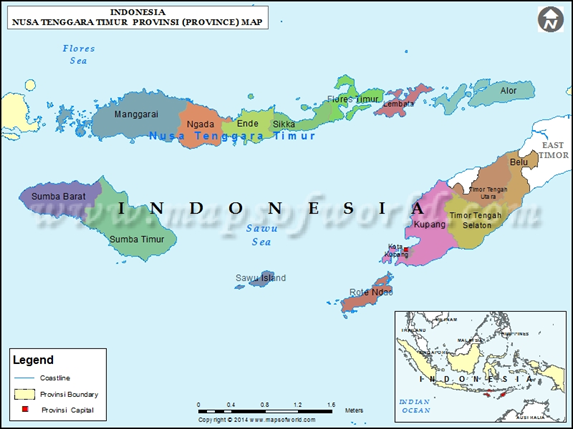
Climate
The country of Indonesia lies within the equatorial belt. In NTT province, the average daily high temperature was around 32 degrees centigrade taken from data over the last 20 years from stations in the province (https://www.worlddata.info/asia/indonesia/climate-east-nusa-tenggara.php). On average, in 2020, from the sections presented below, the rainy season peaks in December / January and the driest months are between June and September.
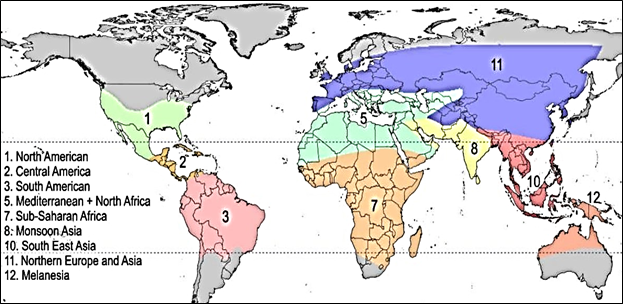
Indonesia (see Figure 2, number 10 on map above) is located in the ecological zone for South East Asia in the tropics with an average of 1000 to 2000 milliliters of rainfall and tropical rainforests (Unninayar, 2015). Specific to NTT province, there are two distinct wet and dry seasons.
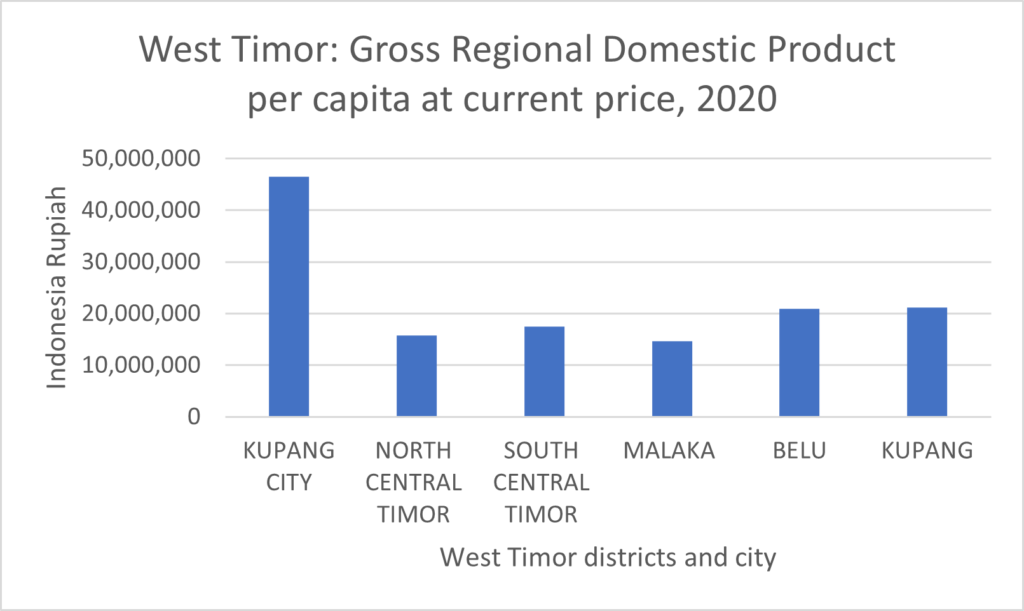
In Graph 1 (above), in 2020, the Kupang City had the highest GRDP while Malaka had the lowest GRDP. Other districts were also well below the City’s GRDP. As noted in the Kupang City Profile (BPS, 2021a), the economy of Kupang City in 2020 contracted by 2,05 % related to the COVID-19 pandemic (p.284).
Social and economic
In 2020, in NTT province, 20.9% of its population lived below the poverty line and while this has reduced in contrast to 2015 statistics, the level of poverty in NTT lags behind the national average of 9.78%. In 2020, there were 13 of 21 districts in the province that were classified as ‘disadvantaged’ or ‘lagging’ areas (daerah tertinggal) and were targeted for development by the President of RI in the Presidential Regulation No. 63 / 2020. The West Timor districts that were named in the disadvantaged areas were districts of Kupang, Belu, Malaka, Timor Tengah Selatan (KEMENDESA news, 11 May 2020).
Literacy in the districts ranged from 87.4% (Malaka) to 99.4% (Kupang City) (BPS, 2021, National Socioeconomic Survey (Susenas) in March 2021) .
Life expectancy In West Timor, the life expectancy at birth was lowest in district Belu (64.61 years) and highest in Kupang City (69.55 years). In contrast, in Indonesia as a whole, the life expectancy at birth was 72 years (The World Bank, 2022). The differential in life expectancy at birth indicator could be due to factors related to living in the city versus living in a rural location. Life expectancy is influenced by several factors such as social and economic status, standards of living, lifestyle, education, access to quality health care (OECD, 2022).
Malaria epidemiology
Between 2018 and 2019, the Province made good progress in malaria elimination with a reduction of 29% of malaria cases and an estimated 1,600 malaria cases with an API of 0.8 cases per 1,000 population (Provincial Health Office, NTT Province, 2019).
In 2018, in Indonesia, malaria incidence was API 0.86 per 1,000 population (NAP) (MoH, 2020, p.3). As noted, in 2020, in the South-East Asia Region, Indonesia had the second highest number of malaria cases and contributed 15.6% of total malaria cases in the region. In contrast, in 2020, India contributed 83% of total malaria cases in the region (WHO, 2021, p. 159).
The NTT province made good progress in efforts to eliminate malaria in most of its 22 administrative locations. In 2021, the malaria incidence in NTT province was estimated at API 1.60 per 1,000 population (E-SISMAL database, NTT province). Three districts have received subnational certification for zero indigenous malaria in the last three years.
In 2019 and 2020, the Kupang City achieved API of 0.09 to 0.06 per 1,000 population. In 2021, the City reported 15 imported and 5 relapsed malaria cases and its API was 0.03 per 1,000. On 27 April 2021, the City was one of three locations awarded a sub-national malaria-free certificate by the Indonesia Ministry of Health, Jakarta, coinciding with World Malaria Day . It was noted that the NTT province malaria program refers to zero indigenous malaria status as ‘elimination’ status.
The district Belu has consistently low API 0.11 and 0.01per 1,000 population, in 2020 and 2021 respectively, and aims for a sub-national malaria-free status certificate by end of 2023. Next in line for malaria elimination certification is the district of Timor Tengah Utara (TTU). See Table below.
The districts Timor Tengah Selatan (TTS) and Malaka have performed well and have reached API < 1 per 1,000. See Table 6 and Graph 5 below for details. A possible reason for the reductions in malaria cases in these two districts could be related to COVID-19 pandemic with travel restrictions within and between locations in NTT province, as well as between NTT and Indonesia and other countries. As mentioned in Section 2 of this report, many people in NTT province provide labour force to Kalimantan and Papua, most likely, to the forestry and mining industries. One district in East Kalimantan, provinces of Papua, and West Papua are high-endemic areas (MoH, 2020a, p.4).
Table 6 Districts are ranked according to API per 1,000 in 2021
| Ranking of API 2021 | District | Population 2020 | API 2019 | API 2020 | API 2021 |
| 1 | BELU | 223,176 | 0.21 | 0.11 | 0.01 |
| 1 | TIMOR TENGAH UTARA (TTU) | 256,299 | 0.31 | 0.06 | 0.02 |
| 2 | TIMOR TENGAH SELATAN (TTS) | 469,673 | 1.54 | 0.18 | 0.10 |
| 3 | MALAKA | 194,776 | 3.28 | 0.33 | 0.20 |
| 4 | KAB. KUPANG | 421,618 | 0.21 | 0.32 | 0.16 |
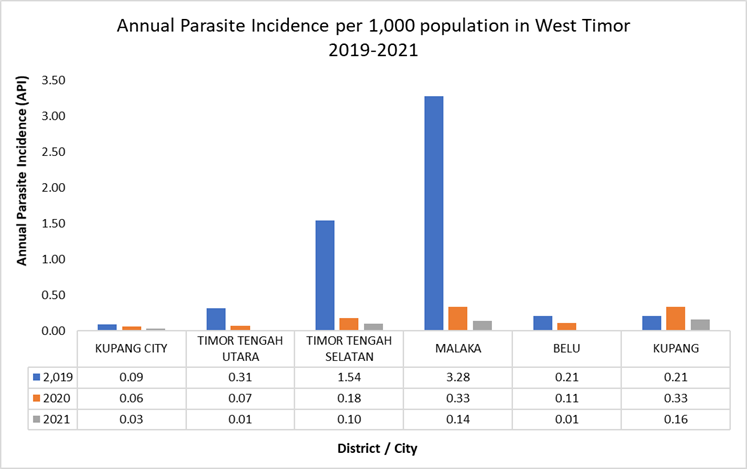
Malaria incidence and rainfall
There is a distinct pattern of high rainy days that were accompanied by high malaria cases (see Graph below). However, malaria is transmitted throughout the year with low transmissions during the dry season with approximately four months of no rain and many parts of the province become drought stricken.
Graph 6: Trend in rainfall and malaria cases in West Timor
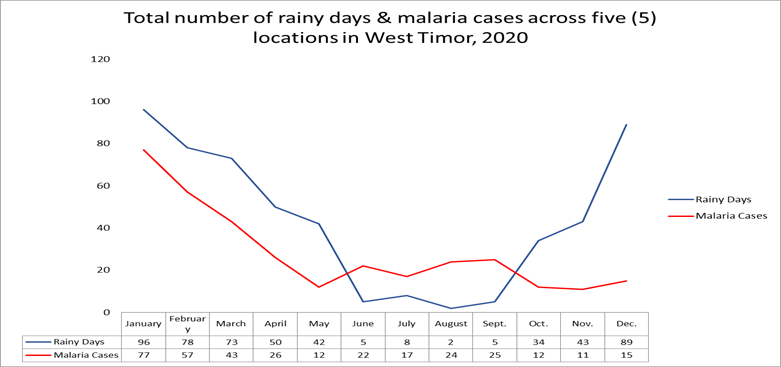
Malaria parasite species, number of cases and trend
In West Timor, the most common plasmodium specie is Plasmodium falciparum that contributed 66 % of total species in the area. The second most common specie is Plasmodium vivax with 31% of total species found in West Timor. Only 3% of cases was caused by mixed species of which 2 cases were either Plasmodium ovale or malariae. Similarly, for NTT province, Plasmodium falciparum is the most common cause of malaria, and second in line is Plasmodium vivax. However, since 2018, West Timor region has experienced a gradual decline in Plasmodium falciparum with 11% increase in Plasmodium vivax and a 1% increase in P ovale /malariae. See Pie chart 1 and Table 7 below (E-SISMAL Updated 28 January 2022, at 9.40 PM WITA by NTT province).
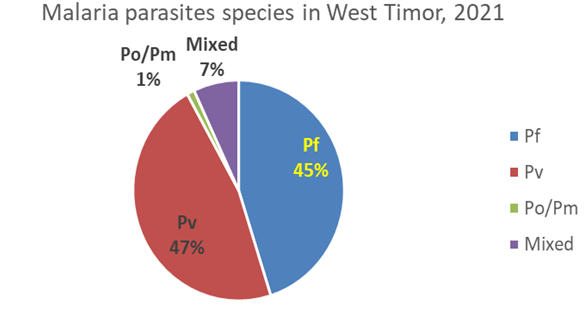
References
BPS (2021a). Kupang City in Numbers 2021. ISSN: 2302-2442
BPS (2021c). District Timor Tengah Utara in Numbers 2021 (BPS Timor Tengah Utara, 2021) ISSN: 2356-1017.
BPS (2021d). District Timor Tengah Selatan in Numbers 2021 (BPS Timor Tengah Selatan, 2021) ISSN: 2302-4461.
BPS (2021e). District Malaka in Numbers in 2021. BPS, District Belu, 2021. ISSN: 53066-2001).
BPS. (2021f). District Belu in Numbers 2021. ISSN: 0215-6962
BPS. (2021g), District Kupang in Numbers 2021, BPS, Kupang, NTT province
KEMENDESA news. (11 May 2020). Accessed on 23 January 2022 from https://www.kemendesa.go.id/berita/view/detil/3261/ini-daerah-tertinggal-menurut-perpres
Kerrison, J. & Yapabandara, M. (2022), West Timor profile. XSPI-RAM Taskforce Report, Scoping Study and Gap Analysis for Acceleration of Malaria Elimination in West Timor (p.18 – 26).
Ministry of Health of the Republic of Indonesia. Director General of Disease Prevention and Control (2020). National Action Plan for Acceleration of Malaria Elimination (NAP) 2020 – 2024. Ministry of Health, Jakarta, Indonesia.
Organization for Economic Cooperation and Development (OECD). (2022), Life expectancy at birth (indicator). doi: 10.1787/27e0fc9d-en (Accessed on 03 February 2022)
Unninayar, S. & Olsen L.M.. (2015). Monitoring, Observations, and Remote Sensing – Global Dimensions, Reference Module in Earth Systems and Environmental Sciences, 2015
WHO. (2015). Considerations for implementation of G6PD testing and radical cure in P. vivax endemic countries. Malaria Policy Advisory Committee Meeting. Geneva, Switzerland. Accessed on 27 January 2022 from https://www.who.int/malaria/mpac/mpac-march2015-erg-g6pd.pdf?ua=1
WHO. (2021). World Malaria Report 2021. Geneva: World Health Organization; 2021. Licence: CC BY-NC-SA 3.0 IGO Accessed on 17 January 2022 from https://www.who.int/teams/global-malaria-programme/reports/world-malaria-report-2021
Last updated 2 June 2022
